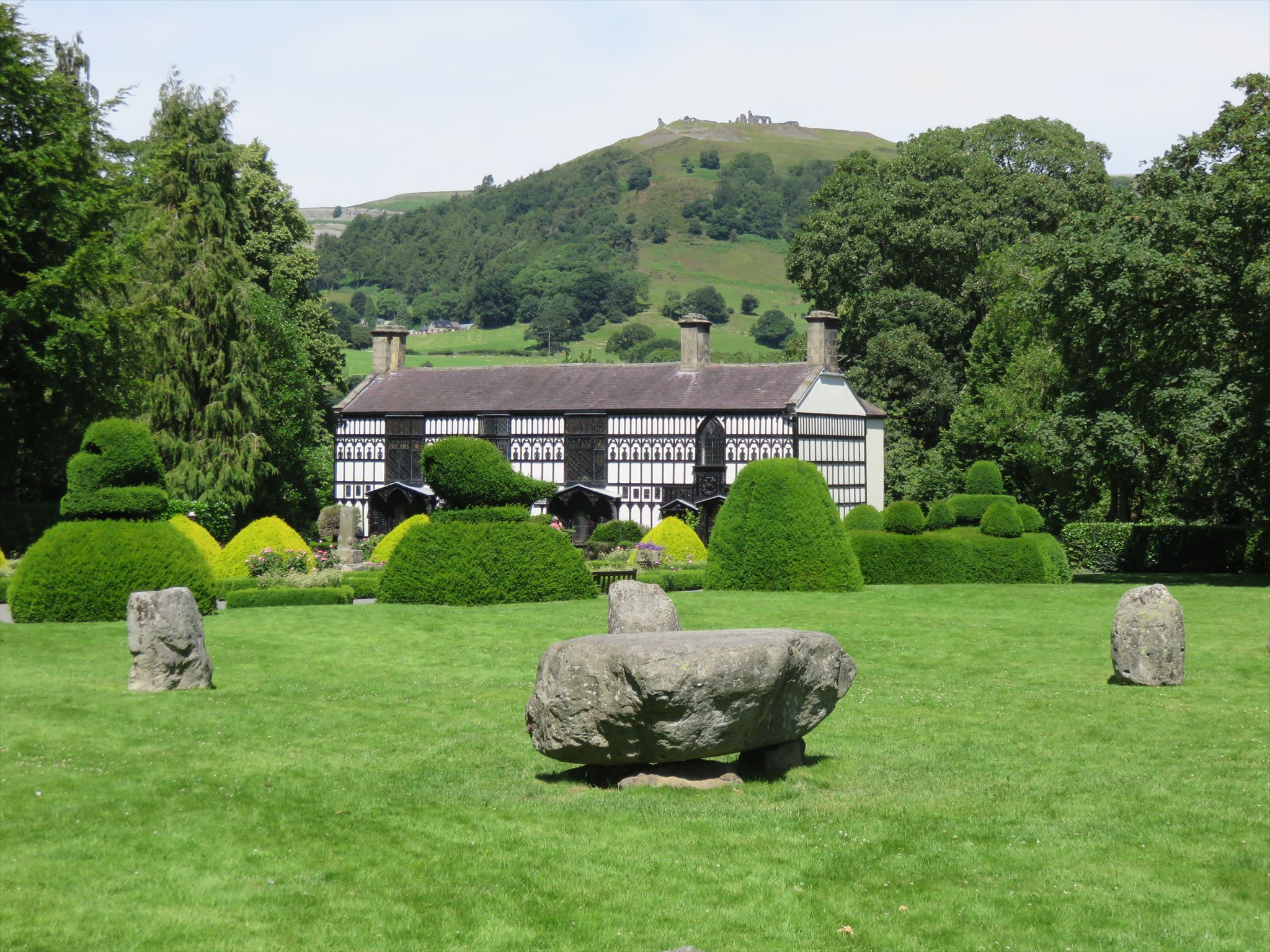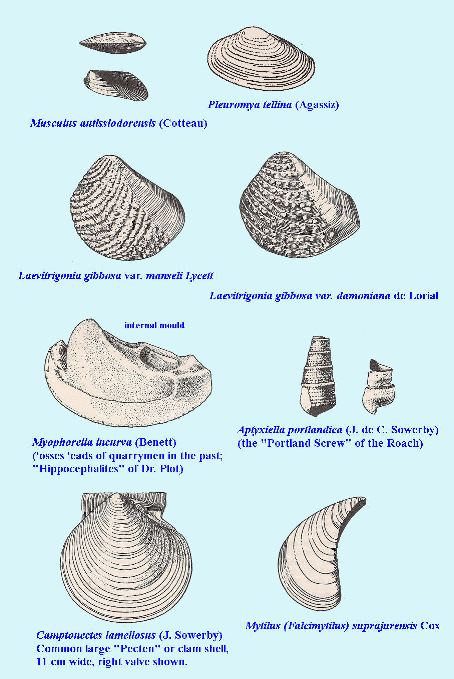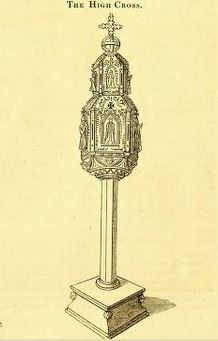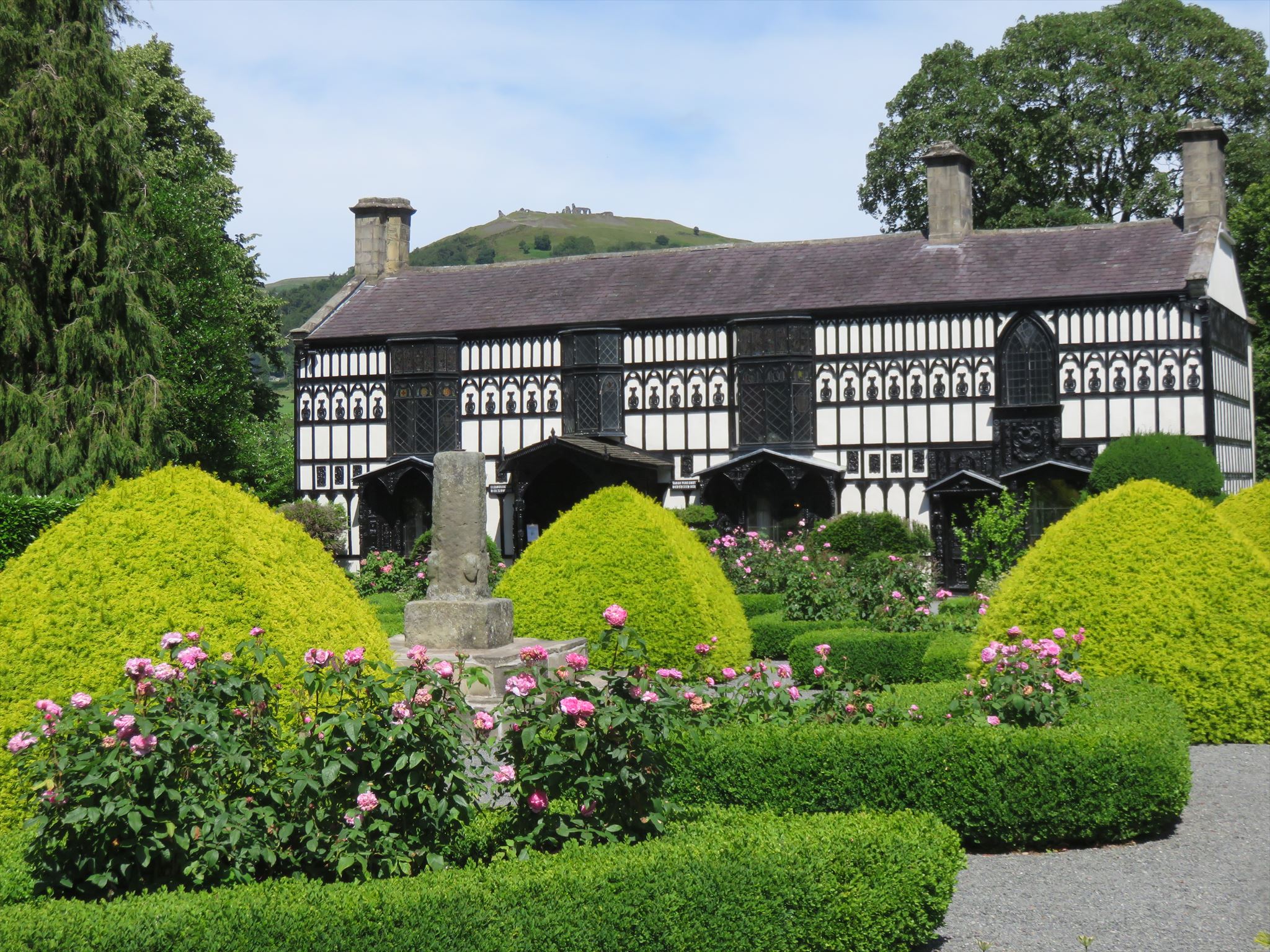The circle consists of a selection of stones (approximately 16) of varying shapes and sizes with a larger flat stone at the centre.

About a third appear to be cup marked; they are very weathered and are of considerable size to the extent that it must have been quite an undertaking to have quarried them and transported them to this place from elsewhere. Although this was not an impossible task for the organisers, it may be that these stones were already on this site.
There is little written about the infamous - to some - Eisteddfod of 1858. This is an extract relating to the Gorsedd stones in question:-
'‘The Gorsedd consisted of the maen arch, or maen llog, the chief stone placed in the centre, round which, in a circle of 30 feet diameter, are the 'meini gwyngil,' being twelve stones set on end, to represent the signs of the zodiac. The sun was considered as a type of God – the Sun of Righteousness; hence the construction of the druidical places of worship in a circular shape. Towards the east, on the outside of the circle, were three other stones, at a distance of nine fathoms from the centre piece, and placed in such positions with respect to the latter, that lines drawn from it, through the three, would indicate the points in the heavens at which the sun rises on the solstices and equinoxes of the year respectively. These lines or pencils of light, as they are termed, form the mystic symbol known amongst the Bards and druids as the Name of God – the 'Word' or attribute of creation – it being held by the Bards that God created the universe by showing and pronouncing His own name. It was, we understand, the original intention of the committee to have the stones of such magnitude, and so placed, as to be a permanent memento of the Eisteddfod, but the ground being a charitable bequest to the inhabitants for the purposes of recreation, of which the Board of Health are trustees, this intention could not conveniently be carried into effect."
The stones are made of Limestone.
Limestone is a sedimentary rock, which means it was formed from small particles of rock or stone that have been compacted by pressure. Sedimentary rock is important because it often contains fossils and gives clues about what type of rock was on the Earth long ago. Just like a tree's rings tell a lot about its environment, layers found in sedimentary rock can tell about important changes in the environment.
How is it formed?
Limestone is formed in two ways. It can be formed with the help of living organisms and by evaporation.
Ocean-dwelling organisms such as oysters, clams, mussels and coral use calcium carbonate (CaCO3) found in seawater to create their shells and bones. As these organisms die, their shells and bones are broken down by waves and settle on the ocean floor where they are compacted over millions of years, creating limestone from the sediments and the pressure of the ocean water.
The second way limestone is formed is when water containing particles of calcium carbonate evaporate, leaving behind the sediment deposit. The water pressure compacts the sediment, creating limestone.
What does it look like?
Because limestone is often formed from shells and bones, it is a light color like white, tan, or gray. The color of the limestone depends on the other sediments in the mixture besides the mineral calcite, which is white; impurities such as sand, clay, and organic material are also present in limestone and affect the color.
There are a few ways to recognize limestone. First of all, it is a soft stone and when it is scratched with a sharp object, it becomes a white powder. When limestone comes in contact with an acid like vinegar or hydrochloric acid (HCl), the stone will actually bubble and deteriorate and then neutralize the acid.
Limestone is also a great source of fossils. In the Eisteddfod stones, fossilised bivalves can be found.

The Chester Cross pillar
At the second waypoint, you will see a pillar in the centre of a small topiary garden. This pillar was the base of the Chester Cross which is situated at the end of Upper Watergate Street in Chester. It was placed at Plas Newydd around 1817. The original medieval cross was destroyed during the Civil War in the name of iconoclasm.

The pillar is made of red sandstone.

The formation of sandstone involves two principal stages. First, a layer or layers of sand accumulates as the result of sedimentation, either from water (as in a stream, lake, or sea) or from air (as in a desert). Typically, sedimentation occurs by the sand settling out from suspension; i.e., ceasing to be rolled or bounced along the bottom of a body of water or ground surface (e.g., in a desert or erg). Finally, once it has accumulated, the sand becomes sandstone when it is compacted by pressure of overlying deposits and cemented by the precipitation of minerals within the pore spaces between sand grains.
The most common cementing materials are silica and calcium carbonate, which are often derived either from dissolution or from alteration of the sand after it was buried. Colours will usually be tan or yellow (from a blend of the clear quartz with the dark amber feldspar content of the sand). A predominant additional colourant in the southwestern United States is iron oxide, which imparts reddish tints ranging from pink to dark red (terracotta), with additional manganese imparting a purplish hue. Red sandstones are also seen in the Southwest and West of Britain, as well as central Europe and Mongolia. The regularity of the latter favours use as a source for masonry, either as a primary building material or as a facing stone, over other construction.
The environment where it is deposited is crucial in determining the characteristics of the resulting sandstone, which, in finer detail, include its grain size, sorting, and composition and, in more general detail, include the rock geometry and sedimentary structures. Principal environments of deposition may be split between terrestrial and marine
The Water Tower

The water tower was built by General Yorke who owned the house from 1876 -1890. He added a west wing to the house and this tower was used to pump water to the bathrooms. The extension became infested with dry rot and was demolished in 1963. The tower was decorated with wooden panelling to match the house but this only extends to the three most visible sides -the fourth is left as rough stone
In order to log this EarthCache, please answer the following questions by messaging us. Please don't include answers in your log
1. One of the Gorsedd stones in particular carries a very interesting image. Describe this image and explain how you think it got there.
2. What evidence is there that the rocks are limestone? Is there anything in them that proves it?
3. Calculate the volume of the central stone
4. In some of the stones there are fossils of small bivalves. What is the approximate size of the fossil you have found? Which type of bivalve did you find?
5. At Waypoint 2: How high is the section of the Chester Cross. What does it feel like? What do you think gives the sandstone it's colour?
6. What evidence is there of weathering? Is it more weathered on any of the faces? Why do you think this is?
7. At Waypoint 3 you will find the Water Tower. The base of the tower contains many different types of rock. Can you name 3 different types of rock in the base of the tower? Why do you think the base of the tower is made of so many different types of rock?
8. As an option, please include photos of yourself/ your group with your logs